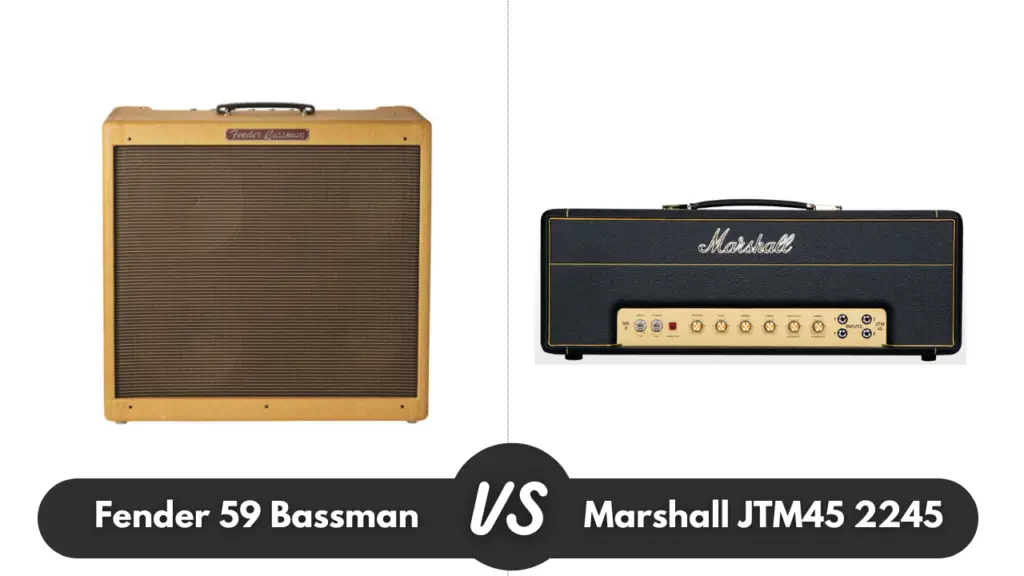For decades, the guitar has been used to produce music that has become important for so many of us through the years. Whether it’s blues or rock, music is the anthem of our lives at each stage of the journey.
However, the amps that we use also play a big part when it comes to playing the guitar. In many cases, the guitar amps were the primary reason for the sounds that we have come to love.
In this article, we’ll take a quick look at Fender’s 59 Bassman and Marshall’s JTM45 2245 Vintage Reissuse to see which one amp is better.
| Features: | Fender 59 Bassman | Marshall JTM45 2245 Vintage Reissuse |
|---|---|---|
| Price: | £1,749 | £1,469 |
| Max Wattage: | 50W | 30W |
| Control Panel: | Presence, Middle, Bass, Treble, Volume (Bright Channel), Volume (Normal Channel) | Presence, bass, middle, treble, high treble/loudness I, normal/loudness II |
| Weight: | 53 lbs. (24 kg) | 32 lbs. (14.6 kg) |
Fender 59 Bassman
Fender’s original Bassman evolved as an amp that was initially designed to go along with the Fender’s Precision Bass. It’s strange as this amp design is among the most revered by guitarists – not bass players. Add to this the fact that Marshall’s first amps were largely leveraged from the Bassman’s circuit design, which went on to inspire a countless array of further clones as time passed, and it’s easy to understand why Fender’s Bassman was the first amp chosen as a tweed reissue in the early 1990s.
Design
Fender’s new ’59 Bassman reissue takes the amp even closer to the original. Updates for Fender’s ’59 Bassman includes a tube rectifier (original spec 5AR4), an internal bias pot, a pair of US-made Groove Tubes 6L6-GE output tubes, as well as a quad of Jensen P10R reissue 10-inch Alnico speakers.
To finish up the revised Bassman, the ’59 is housed in a cabinet constructed from solid finger-jointed yellow pine and covered in lacquered Tweed, just as the originals were. The front covering is an attractive dark oxblood type cloth, which again is like the originals.
Beyond the updated improvements, the 59 Bassman shares the same four-input, two-channel design with independent controls for volume on each channel in addition to Presence, Bass, Middle, and Treble controls that go to 12. The two channels (normal and bright emphasized) can be patched together with a short cord that combines the voices. Although it’s important to know that the two channels doesn’t mean that it’s a “channel-switching” amp. The amp is rated at 50 watts and certainly puts out the power. This amp is certainly capable of being VERY loud, especially if you have more of an interest in clear clean tones.
Fender’s Bassman design is straight up and simple with no preamp gain controls for low-level distortion creation. Although the amp doesn’t have effects loops, reverbs, or extra buttons or lights. With being said, blues and classic rock players tend to appreciate the non-master volume style of amps as the volume can be set to a breakup point of natural distortion while the dynamics can then be controlled by the player’s technique. This touch sensitivity can really enhance the mood and feel of the music being played. If you want an amp like the ’59 Bassman to distort, then you’ve simply got to turn it up.
Sound Quality
Marshall JTM45 2245
Marshall’s JTM45 is reputed as being one of the finest amp heads in the world, and the originals cost really big money these days too. But you might have known that Marshall amps would one day take current technology and make a reissue.
Design
The JTM45 is like the original in all intents and purposes. It has a regular and higher gain input, Treble Mid and Bass with a Presence control, along with an on and off switch and the inimitable standby switch. Again, don’t get excited about the effects loop – there isn’t one, and neither was there one on the original. If you were after a replica, then that’s what you got. You can use the old trick of looping the two inputs together to expand the tone of the amp, and it works fine.
But, remember one thing, while this amp is rated at a conservative 30 watts and uses two 5881’s and a tube rectifier, it’s certainly still a loud enough amp for gigging, and could well be too loud for the bedroom if that’s where you practice or play.
Externally other than the power connector and a couple of changes at the back of the amp, it looks just like the original and near enough all of your audience will be asking where you got that JTM45 from. If you play classic rock or blues, then you can’t go wrong with this amp. However, if you play death metal or detuned stuff, then this amp won’t be for you. Meanwhile, the other more controlled styles should fare well with this amp.
Sound Quality
Conclusion
So, which amp is better? Well, considering the fact that these amps are considered to be siblings, there isn’t a huge difference between the two. They practically use the same circuit, while the transformers and speakers are different, and of course, that’ll affect the final sound quite a bit!
